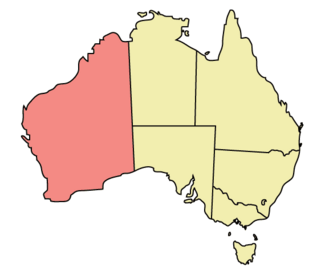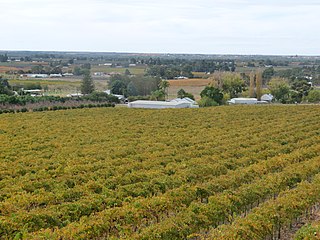
The Clare Valley wine region is one of Australia's oldest wine regions, best known for Riesling wines. It lies in the Mid North of South Australia, approximately 120 km north of Adelaide. The valley runs north-south, with Horrocks Highway as the main thoroughfare.

The South Australian wine industry is responsible for more than half the production of all Australian wine. South Australia has a vast diversity in geography and climate which allows the state to be able to produce a range of grape varieties–from the cool climate Riesling variety in the Clare Valley wine region to the big, full bodied Shiraz wines of the Barossa Valley.

Victorian wine is wine made in the Australian state of Victoria. With over 600 wineries, Victoria has more wine producers than any other Australian wine-producing state but ranks third in overall wine production due to the lack of a mass bulk wine-producing area like South Australia's Riverland and New South Wales's Riverina. Viticulture has existed in Victoria since the 19th century and experienced a high point in the 1890s when the region produced more than half of all wine produced in Australia. The phylloxera epidemic that soon followed took a hard toll on the Victoria wine industry which did not fully recover till the 1950s.

New South Wales wine is Australian wine produced in New South Wales, Australia. New South Wales is Australia's most populous state and its wine consumption far outpaces the region's wine production. The Hunter Valley, located 130 km (81 mi) north of Sydney, is the most well-known wine region but the majority of the state's production takes place in the Big Rivers zone-Perricoota, Riverina and along the Darling and Murray Rivers. The wines produced from the Big Rivers zone are largely used in box wine and mass-produced wine brands such as Yellow Tail. A large variety of grapes are grown in New South Wales, including Cabernet Sauvignon, Chardonnay, Shiraz and Sémillon.

Western Australian wine refers to wine produced in Australia's largest state, Western Australia. Although the state extends across the western third of the continent, its wine regions are almost entirely situated in the cooler climate of its south-western tip. Western Australia produces less than 5% of the country's wine output, but in quality terms it is very much near the top.

Fleurieu zone is a wine zone located south of Adelaide in South Australia. It extends from Kangaroo Island in the west as far north as Flagstaff Hill on the west side of the Mount Lofty Ranges and to as far north as Langhorne Creek on the east side of the Mount Lofty Ranges. It consists of the following five wine regions, each of which has received appellation as an Australian Geographical Indication (AGI): Currency Creek, Kangaroo Island, Langhorne Creek, McLaren Vale and the Southern Fleurieu.
Southern Fleurieu wine region is a wine region in South Australia that is located on the Fleurieu Peninsula and the portion of the Mount Lofty Ranges extending north east from the peninsula to near Willunga in the west and to near Ashbourne in the east. The region received appellation as an Australian Geographical Indication (AGI) in 2001 and as of 2014, has a total planted area of 510 ha and is represented by 50 growers and at least 19 wineries.

The Peninsulas zone is a wine zone located in South Australia that covers the entire Yorke Peninsula, an adjoining portion of the Mid North of South Australia, the portion of Eyre Peninsula south of a line of latitude approximately in line with Crystal Brook and the islands located off the adjoining coastline. The zone is bounded by the Far North zone to its north by the Mount Lofty Ranges zone to its east. The term ‘The Peninsulas’ was registered as an Australian Geographical Indication under the Wine Australia Corporation Act 1980 on 27 December 1996.

Far North zone is a wine zone located in the state of South Australia which covers the entire extent of the state north of a line of latitude approximately in line with Crystal Brook, i.e. 33 degrees 21 minutes south. The zone is bounded by the following wine zones to its south: The Peninsulas, the Mount Lofty Ranges and the Lower Murray. The term ‘Far North’ was registered as an Australian Geographical Indication under the Wine Australia Corporation Act 1980 on 27 December 1996. As of 2003, the zone only contains one region - the Southern Flinders Ranges.

Lower Murray zone is a wine zone located in the state of South Australia which covers the portion of the state south of a line of latitude approximately in line with Crystal Brook, east of a line of longitude approximately in line with Truro and north of a line of latitude approximately in line with Cape Willoughby at the east end of Kangaroo Island. The zone is bounded by the following wine zones: Far North to its north, the Mount Lofty Ranges, Barossa and Fleurieu to its west and the Limestone Coast to its south. The term ‘Lower Murray’ was registered as an Australian Geographical Indication under the Wine Australia Corporation Act 1980 on 7 December 1996. As of 1998, the zone only contains one region - the Riverland.

Mount Lofty Ranges zone is a wine zone located in central South Australia west of the Murray River that occupies the Adelaide metropolitan area north of Glenelg, extending as far north as Crystal Brook, and as far south as Mount Compass in the Mount Lofty Ranges. The zone which encloses the Barossa zone on three sides, consists of the following wine regions all of which have received appellation as an Australian Geographical Indication (AGI): Adelaide Hills, Adelaide Plains and Clare Valley. The zone received AGI in 1996.
Lenswood wine sub-region is a wine sub-region located around the town of Lenswood in South Australia within the Mount Lofty Ranges to the east of the Adelaide city centre. The sub-region received appellation as an Australian Geographical Indication (AGI) on 16 October 1998. The sub-region is part of the Adelaide Hills wine region and the Mount Lofty Ranges zone.

Piccadilly Valley wine sub-region is a wine sub-region in South Australia located between the town of Summertown in the north and the towns of Stirling and Aldgate to its south in the Mount Lofty Ranges to the east of the Adelaide city centre. The sub-region received appellation as an Australian Geographical Indication (AGI) on 14 April 2000. The sub-region is part of the Adelaide Hills wine region and the Mount Lofty Ranges zone.

Barossa zone is a wine zone located in central South Australia west of the Murray River and which occupies the Barossa Valley, the Eden Valley and some adjoining land. The zone which is enclosed by the Mount Lofty Ranges zone on three sides and by the Lower Murray zone to its east, contains two wine regions which have received appellation as Australian Geographical Indications (AGI). These are the Barossa Valley and Eden Valley regions. The Barossa zone also includes a broader area around these two defined regions. The zone received AGI in 1996.
Hilltops is an Australian Geographical Indication for a wine region in the Southern New South Wales zone of the state of New South Wales in Australia. It includes the main towns of Boorowa, Harden and Young,.
Swan Hill is a wine region name protected by an Australian Geographical Indication (AGI). It is named for the town of Swan Hill on the south side of the Murray River in the Australian state of Victoria. The wine region spans the Murray and the north eastern part of the region is in the state of New South Wales. The north eastern part of the region is in the New South Wales zone of Big Rivers. The southern and western parts are in the Victoria zone of North West Victoria. The region spans from Lake Charm and Benjeroop in the southeast through Lake Boga and Swan Hill to past Piangil and Tooleybuc in the north.
Gundagai is an Australian Geographical Indication for a wine region centred on the town of Gundagai in the Australian state of New South Wales. It is part of the Southern New South Wales zone. The region includes Tumut on the northwestern slopes of the Snowy Mountains, Cootamundra in its north and extends west to Junee and almost to Wagga Wagga. Junee is on the boundary to the Riverina wine region. Gundagai is also bounded on the northeast by Hilltops, the east by Canberra District and the south by Tumbarumba.












